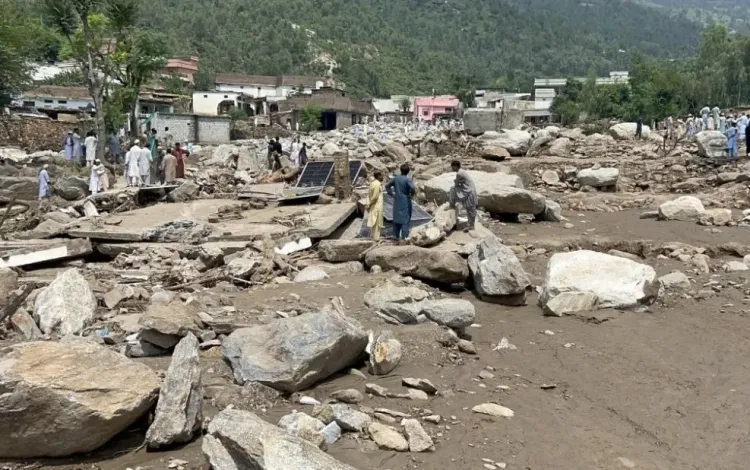How Is the Government's Negligence Fueling the Monsoon Disaster in Pakistan?

Synopsis
Key Takeaways
- Over 657 lives lost due to flooding and landslides since late June.
- K-P recorded the highest number of casualties.
- The Billion Tree Tsunami project has been labeled a fraud.
- Rampant deforestation has exacerbated vulnerability to floods.
- Government negligence has played a significant role in the crisis.
Islamabad, Aug 19 (NationPress) The relentless monsoon season has brought about catastrophic conditions throughout Pakistan, resulting in significant loss of life and widespread destruction due to floods and landslides, as indicated by local media sources.
Since late June, at least 657 individuals have lost their lives, with nearly 1,000 others injured in rain-related incidents.
On Monday alone, over 400 fatalities were reported from various areas, including Buner, Swat, Shangla, Bajaur, Pakistan-occupied Gilgit-Baltistan (PoGB), and Pakistan-occupied Kashmir (PoK).
With numerous homes completely destroyed, funeral services are now taking place in muddy fields, resonating with sorrow throughout the valleys of Pakistan. This disaster has laid bare the country's vulnerability to climate change and the lack of effective institutional readiness, as articulated by Zafar Khan Safdar, a research scholar writing for the prominent publication, Pakistan Observer.
In Khyber Pakhtunkhwa (K-P), which recorded the highest number of casualties, the provincial government has reportedly made little progress in the past 15 years, with only slogans and unfulfilled promises to show for it.
Moreover, the much-publicized Billion Tree Tsunami initiative, hailed as a groundbreaking environmental reform, has been revealed as a fraudulent scheme where trees were never planted, lands were misallocated, and billions were misappropriated, leaving the hills of Swat and Dir barren.
The Malam Jabba land scandal in K-P further underscores the misuse of natural resources as avenues for corruption.
In the Swabi district of K-P, the torrential rains led to the deaths of 17 people on Monday after their homes were inundated, and several were swept away by landslides. Two additional fatalities were reported in the Nowshera district.
According to Swabi Deputy Commissioner Nasrullah Khan, a cloudburst in Dalori village resulted in the flooding of 12 homes, while landslides occurred in the region's hilly areas.
The heavy rainfall and landslides wreaked havoc in the Gadoon Amazai mountainous region, where flash floods inundated numerous homes and swept away several residents.
The Pakistan Observer highlighted that rampant deforestation and uncontrolled tree cutting in K-P have stripped away the natural barriers that forests once provided against landslides and flooding.
It was further noted that had the government prioritized the protection of forests, the restoration of watersheds, and the maintenance of infrastructure, countless lives could have been preserved during this devastating flood.
In the end, many lives were lost not solely due to the floodwaters but also due to gross negligence, mismanagement, and a broken system devoid of necessary checks and balances.









